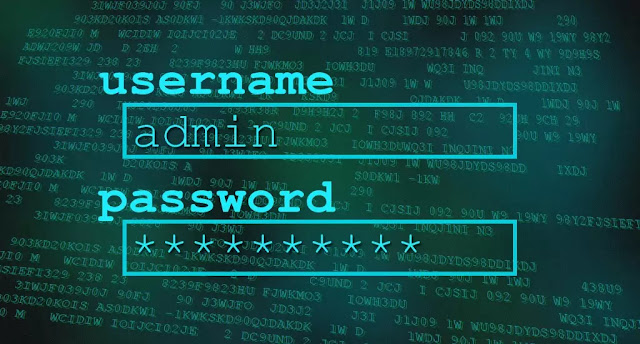Password Cracking Techniques
Password Cracking Techniques
 |
| Password Cracking Techniques |
Password Cracking
In cryptanalysis and computer security, password cracking is the process of recovering passwords from data that have been stored in or transmitted by a computer system. A common approach is to repeatedly try guesses for the password and to check them against an available cryptographic hash of the password.The purpose of password cracking might be to help a user recover a forgotten password, to gain unauthorized access to a system, or to act as a preventive measure whereby system administrators check for easily crackable passwords. On a file-by-file basis, password cracking is utilized to gain access to digital evidence to which a judge has allowed access when a particular file's permissions are restricted.
The time needed for password searches
The time to crack a password is related to bit strength, which is a measure of the password's entropy, and the details of how the password is stored. Most methods of password cracking require the computer to produce many candidate passwords, each of which is checked. One example is brute-force cracking, in which a computer tries every possible key or password until it succeeds.
With multiple processors, this time can be optimized through searching from the last possible group of symbols and the beginning at the same time, with other processors being placed to search through a designated selection of possible passwords. More common methods of password cracking, such as dictionary attacks, pattern checking, word list substitution, etc. attempt to reduce the number of trials required and will usually be attempted before brute force. Higher password bit strength exponentially increases the number of candidate passwords that must be checked, on average, to recover the password and reduces the likelihood that the password will be found in any cracking dictionary.
The ability to crack passwords using computer programs is also a function of the number of possible passwords per second which can be checked. If a hash of the target password is available to the attacker, this number can be in the billions or trillions per second, since an offline attack is possible. If not, the rate depends on whether the authentication software limits how often a password can be tried, either by time delays, CAPTCHAs or forced lockouts after some number of failed attempts. Another situation where quick guessing is possible is when the password is used to form a cryptographic key.
In such cases, an attacker can quickly check to see if a guessed password successfully decodes encrypted data.
For some kinds of the password hash, ordinary desktop computers can test over a hundred million passwords per second using password cracking tools running on a general-purpose CPU and billions of passwords per second using GPU-based password cracking tools.
The rate of password guessing depends heavily on the cryptographic function used by the system to generate password hashes. A suitable password hashing function, such as bcrypt, is many orders of magnitude better than a naive function like simple MD5 or SHA. A user-selected eight-character password with numbers, mixed case, and symbols, with commonly selected passwords and other dictionary matches filtered out, reaches an estimated 30-bit strength, according to NIST.
230 is only one billion permutations and would be cracked in seconds if the hashing function is naive. When ordinary desktop computers are combined in a cracking effort, as can be done with botnets, the capabilities of password cracking are considerably extended. In 2002, distributed.net successfully found a 64-bit RC5 key in four years, in an effort which included over 300,000 different computers at various times, and which generated an average of over 12 billion keys per second.
Graphics processors can speed up password cracking by a factor of 50 to 100 over general-purpose computers. As of 2011, available commercial products claim the ability to test up to 2,800,000,000 passwords a second on a standard desktop computer using a high-end graphics processor. Such a device can crack a 10 letter single-case password in one day. The work can be distributed over many computers for an additional speedup proportional to the number of available computers with comparable GPUs.
The emergence of hardware acceleration over the past decade GPU resources to be used to increase the efficiency and speed of a brute force attack. In 2012, Stricture Consulting Group unveiled a 25-GPU cluster that achieved a brute force attack speed of 350 billion guesses per second, allowing them to check 95^8password combinations in 5.5 hours. Using oil-Hashcat Plus on a Virtual OpenCL cluster platform, the Linux-based GPU cluster was used to "crack 90 per cent of the 6.5 million password hashes belonging to users of LinkedIn.
Despite their capabilities, desktop CPUs are slower at cracking passwords than purpose-built password breaking machines. In 1998, the Electronic Frontier Foundation built a dedicated password cracker using ASICs, as opposed to general-purpose CPUs. Their machine, Deep Crack, broke a DES 56-bit key in 56 hours, testing over 90 billion keys per second. In 2010, the Georgia Tech Research Institute developed a method of using GPGPU to crack passwords, coming up with a minimum secure password length of 12 characters.
Easy to remember, hard to guess
Passwords that are difficult to remember will reduce the security of a system because users might need to write down or electronically store the password using an insecure method, users will need frequent password resets and users are more likely to re-use the same password. Similarly, the more stringent requirements for password strength, e.g. "have a mix of uppercase and lowercase letters and digits" or "change it monthly", the greater the degree to which users will subvert the system.In "The Memorability and Security of Passwords", Jeff Yan et al. examines the effect of advice given to users about a good choice of password. They found that passwords based on thinking of a phrase and taking the first letter of each word are just as memorable as naively selected passwords, and just as hard to crack as randomly generated passwords. Combining two unrelated words is another good method. Having a personally designed "algorithm" for generating obscure passwords is another good method.
However, asking users to remember a password consisting of a "mix of uppercase and lowercase characters" is similar to asking them to remember a sequence of bits: hard to remember, and only a little bit harder to crack. Asking users to use "both letters and digits" will often lead to easy-to-guess substitutions such as 'E' → '3' and 'I' → '1', substitutions which are well known to attackers. Similarly typing the password one keyboard row higher is a common trick known to attackers.
Research detailed in an April 2015 paper by several professors at Carnegie Mellon University shows that people's choices of password structure often follow several known patterns. As a result, passwords may be much more easily cracked than their mathematical probabilities would otherwise indicate. Passwords containing one digit, for example, disproportionately include it at the end of the password.
Incidents
On July 16, 1998, CERT reported an incident where an attacker had found 186,126 encrypted passwords. By the time they were discovered, they had already cracked 47,642 passwords.In December 2009, a major password breach of the Rockyou.com website occurred that led to the release of 32 million passwords. The attacker then leaked the full list of the 32 million passwords to the internet. Passwords were stored in cleartext in the database and were extracted through a SQL Injection vulnerability. The Imperva Application Defense Center did an analysis of the strength of the passwords.
In June 2011, NATO experienced a security breach that led to the public release of first and last names, usernames, and passwords for more than 11,000 registered users of their e-bookshop. The data were leaked as part of Operation AntiSec, a movement that includes Anonymous, LulzSec, as well as other hacking groups and individuals.
On July 11, 2011, Booz Allen Hamilton, a large American Consulting firm that does a substantial amount of work for the Pentagon, had their servers hacked by Anonymous and leaked the same day. "The leak, dubbed 'Military Meltdown Monday,' includes 90,000 logins of military personnel—including personnel from USCENTCOM, SOCOM, the Marine Corps, various Air Force facilities, Homeland Security, State Department staff, and what looks like private sector contractors." These leaked passwords wound up being hashed with unsalted SHA-1, and were later analyzed by the ADC team at Imperva, revealing that even some military personnel used passwords as weak as "1234".
On July 18, 2011, Microsoft Hotmail banned the password: "123456".
In July 2015, a group calling itself "The Impact Team" stole the user data of Ashley Madison. Many passwords were hashed using both the relatively strong bcrypt algorithm and the weaker MD5 hash. Attacking the latter algorithm allowed some 11 million plaintext passwords to be recovered.
Prevention
The best method of preventing a password from being cracked is to ensure that attackers cannot get access even to the hashed password. For example, on the Unix operating system, hashed passwords were originally stored in a publicly accessible file /etc/passwd. On modern Unix systems, on the other hand, they are stored in the shadow password file /etc/shadow, which is accessible only to programs running with enhanced privileges .This makes it harder for a malicious user to obtain the hashed passwords in the first instance, however many collections of password hashes have been stolen despite such protection. Another strong approach is to combine a site-specific secret key with the password hash, which prevents plaintext password recovery even if the hashed values are purloined. A third approach is to use key derivation functions that reduce the rate at which passwords can be guessed.
Unfortunately, many common Network Protocols transmit passwords in cleartext or use weak challenge/response schemes.
Modern Unix systems have replaced traditional DES-based password hashing function crypt with stronger methods such as bcrypt and scrypt. Other systems have also begun to adopt these methods. For instance, the Cisco IOS originally used a reversible Vigenère cypher to encrypt passwords, but now uses md5-crypt with a 24-bit salt when the "enable secret" command is used. These newer methods use large salt values which prevent attackers from efficiently mounting offline attacks against multiple user accounts simultaneously. The algorithms are also much slower to execute which drastically increases the time required to mount a successful offline attack.
Many hashes used for storing passwords, such as MD5 and the SHA family, are designed for fast computation and efficient implementation in hardware. As a result, they are ineffective in preventing password cracking, especially with methods like rainbow tables. Using key stretching Algorithms, such as PBKDF2, to form password hashes can significantly reduce the rate at which passwords can be tested.
Solutions like a security token give a formal proof answer by constantly shifting password. Those solutions abruptly reduce the timeframe for brute-forcing and they reduce the value of the stolen passwords because of its short time validity.
In 2013 a long-term Password Hashing Competition was announced to choose a new, standard algorithm for password hashing.
Software
There are many password cracking software tools, but the most popular are Aircrack, Cain and Abel, John the Ripper, Hashcat, Hydra, DaveGrohl and ElcomSoft. Many litigation support software packages also include password cracking functionality. Most of these packages employ a mixture of cracking strategies, the algorithm with brute force and dictionary attacks proving to be the most productive.The increased availability of computing power and beginner-friendly automated password cracking software for a number of protection schemes has allowed the activity to be taken up by script kiddies.



Comments
Post a Comment